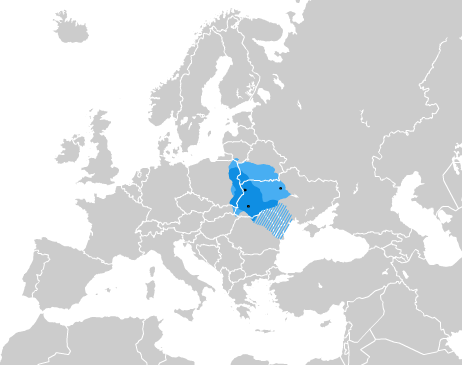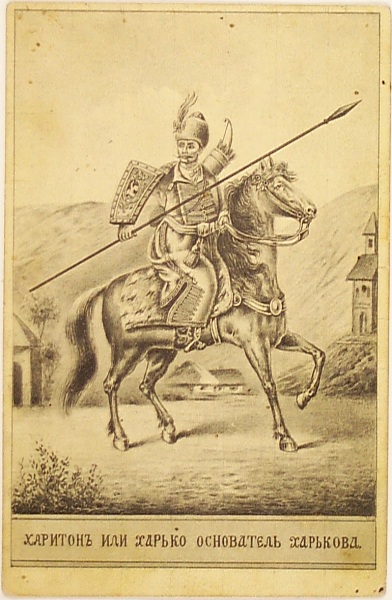|
Ukrainian Social Democratic Labour Party
The Ukrainian Social Democratic Labour Party (), also commonly known as Esdeky (), was a social-democratic political party in the Ukrainian People's Republic. The party was reformed in 1905 at the Second Congress of the Revolutionary Ukrainian Party and was pursuing Marxism through the Social Democratic Party of Germany's Erfurt Program as well as national and cultural autonomy.Klymenko, A. Passionaries of the Ukrainian Revolution. How supporters of independence became Communists (Пасіонарії Української революції. Як прихильники незалежності комуністами стали)'. DS News. 14 October 2017 Party leaders were Volodymyr Vynnychenko, Symon Petliura, Mykola Porsh, Dmytro Antonovych, Lev Yurkevych, Mykhailo Tkachenko, and Mykola Kovalsky. The party identified its priority by resolving national matters and pushing its struggle for social liberalization of the working class to the secondary set. In the spring of 190 ... [...More Info...] [...Related Items...] OR: [Wikipedia] [Google] [Baidu] |
Volodymyr Vynnychenko
Volodymyr Kyrylovych Vynnychenko (; – March 6, 1951) was a Ukrainian statesman, political activist, writer, playwright and artist who served as the first List of prime ministers of Ukraine, prime minister of the Ukrainian People's Republic.100 years ago the Central Rada formed the first government of Ukraine (infographics) ''100 років тому Центральна Рада створила перший уряд України (інфографіка)'' Radio Free Europe (28 June 2017) As a writer, Vynnychenko is recognized in Ukrainian literature as a leading Modernist literature, modernist writer ... [...More Info...] [...Related Items...] OR: [Wikipedia] [Google] [Baidu] |
Soviet Propaganda
Propaganda in the Soviet Union was the practice of state-directed communication aimed at promoting class conflict, proletarian internationalism, the goals of the Communist Party of the Soviet Union, and the party itself. The main Soviet censorship body, Glavlit, was employed not only to eliminate any undesirable printed materials but also "to ensure that the correct ideological spin was put on every published item." After the death of Joseph Stalin, punitive measures were replaced by punitive psychiatry, prison, denial of work, and loss of citizenship. Theory of propaganda According to historian Peter Kenez, "the Russian socialists have contributed nothing to the theoretical discussion of the techniques of mass persuasion. ... The Bolsheviks never looked for and did not find devilishly clever methods to influence people's minds, to brainwash them." Kenez says this lack of interest "followed from their notion of propaganda. They thought of propaganda as part of education." ... [...More Info...] [...Related Items...] OR: [Wikipedia] [Google] [Baidu] |
Union For The Liberation Of Ukraine
The Union for the Liberation of Ukraine (, СВУ; Soiuz vyzvolennia Ukrainy, SVU) was a political organization that was established on 4 August 1914 in Lviv, Lemberg, Kingdom of Galicia and Lodomeria.Lavrov, Yu. Union for the Liberation of Ukraine, SVU (СОЮЗ ВИЗВОЛЕННЯ УКРАЇНИ (СВУ))'. Encyclopedia of History of Ukraine. The organization was established by Ukrainian emigrants from the Russia-held Dnieper Ukraine and who were socialist by their political views representing such political parties like Revolutionary Ukrainian Party (RUP), Ukrainian Social Democratic Workers Party (USDRP), "Spilka" Socialist-Democratic ("Fellowship"). The organization was headed by its presidium that consisted of Andriy Zhuk, Volodymyr Doroshenko, Oleksandr Skoropys-Yoltukhovskyi, and Markian Melenevskyi. See also * Persecuted bandurists * Union for the Freedom of Ukraine trial References Sources *Roman Malko, "Music from the shadows", Zerkalo Nedeli, September 14–20, 20 ... [...More Info...] [...Related Items...] OR: [Wikipedia] [Google] [Baidu] |
Volodymyr Doroshenko
Volodymyr (, ; ) is a Ukrainian given name of Old East Slavic origin. The related Ancient Slavic, such as Czech, Russian, Serbian, Croatian, etc. form of the name is Володимѣръ ''Volodiměr'', which in other Slavic languages became Vladimir (from ). Diminutives include Volodyk, Volodia and Vlodko. People named Volodymyr include: * Volodymyr the Great (aka St. Volodymyr, Volodymyr I of Kyiv), Grand Prince of Kyiv * Volodymyr Atamanyuk (born 1955), Soviet footballer * Volodymyr Bahaziy (1902–1942), Ukrainian nationalist * Volodymyr Barilko (born 1994), Ukrainian football striker * Volodymyr Bezsonov (born 1958), Ukrainian football manager and player * Volodymyr Boyko (1938–2015), Ukrainian entrepreneur and politician * Volodymyr Chesnakov (born 1988), Ukrainian footballer * Volodymyr Demchenko (born 1981), Ukrainian sprinter who competed in the 2004 Summer Olympics * Volodymyr Dyudya (born 1983), Ukrainian racing cyclist * Volodymyr Gerun (born 1994), Ukrainian basket ... [...More Info...] [...Related Items...] OR: [Wikipedia] [Google] [Baidu] |
Dmytro Dontsov
Dmytro Ivanovych Dontsov (; – 30 March 1973) was a Ukrainian nationalist writer, publisher, journalist and political thinker whose radical ideas, known as integral nationalism, were a major influence on the Organization of Ukrainian Nationalists. Biography Dontsov was born in Melitopol, Taurida Governorate (today Zaporizhzhia Oblast) to an old Cossack officer's family, and in 1900 moved to Saint Petersburg to study law. In 1905 he joined the Ukrainian Social-Democratic Labor Party (USDRP) and met and befriended Symon Petliura. Dontsov's first published articles were published in the magazine ''Slovo'' which was edited by Petliura. Between 1905 and 1907, Dontsov was arrested twice due to his involvement in socialist politics. Dontsov moved to Lviv in April 1908, where in 1917 he completed his doctorate in law. In 1913, he quit the USDRP due to the conflict based on the national question. During the time of the Ukrainian War of Independence, Dontsov served in the gove ... [...More Info...] [...Related Items...] OR: [Wikipedia] [Google] [Baidu] |
World War I
World War I or the First World War (28 July 1914 – 11 November 1918), also known as the Great War, was a World war, global conflict between two coalitions: the Allies of World War I, Allies (or Entente) and the Central Powers. Fighting took place mainly in European theatre of World War I, Europe and the Middle Eastern theatre of World War I, Middle East, as well as in parts of African theatre of World War I, Africa and the Asian and Pacific theatre of World War I, Asia-Pacific, and in Europe was characterised by trench warfare; the widespread use of Artillery of World War I, artillery, machine guns, and Chemical weapons in World War I, chemical weapons (gas); and the introductions of Tanks in World War I, tanks and Aviation in World War I, aircraft. World War I was one of the List of wars by death toll, deadliest conflicts in history, resulting in an estimated World War I casualties, 10 million military dead and more than 20 million wounded, plus some 10 million civilian de ... [...More Info...] [...Related Items...] OR: [Wikipedia] [Google] [Baidu] |
Western Ukraine
Western Ukraine or West Ukraine (, ) refers to the western territories of Ukraine. There is no universally accepted definition of the territory's boundaries, but the contemporary Ukrainian administrative regions ( oblasts) of Chernivtsi, Ivano-Frankivsk, Lviv, Ternopil and Zakarpattia (which were part of the former Austro-Hungarian Empire) are typically included. In addition, Volyn and Rivne oblasts (parts of the territory annexed from the Polish–Lithuanian Commonwealth during its Third Partition) are also usually included. In modern sources, Khmelnytskyi Oblast is often included because of its geographical, linguistic and cultural association with Western Ukraine, although this can not be confirmed from a historical and political point of view. It includes several historical regions such as Carpathian Ruthenia, Halychyna including Pokuttia (the eastern portion of Eastern Galicia), most of Volhynia, northern Bukovina and the Hertsa region, and Podolia. Western Ukraine ... [...More Info...] [...Related Items...] OR: [Wikipedia] [Google] [Baidu] |
General Jewish Labour Bund In Lithuania, Poland And Russia
The General Jewish Labour Bund in Lithuania, Poland and Russia (), generally called The Bund (, cognate to , ) or the Jewish Labour Bund (), was a secular Jewish socialist party initially formed in the Russian Empire and active between 1897 and 1920. A member of the Bund was called a '' Bundist''. Between 1898 and 1903, the Bund was an autonomous part of the Russian Social Democratic Labour Party, but left after the Second Congress. In 1917, the Bund organizations in Poland seceded from the Russian Bund and created a new Polish General Jewish Labour Bund which continued to operate in Poland in the years between the two world wars. The majority faction of the Russian Bund was dissolved in 1921 and incorporated into the Communist Party. Other remnants of the Bund endured in various countries. Founding During the mid-to-late 19th century eastern Europe, Jewish politics was shifting away from the oligarchic politics of the ''kehilla'', and religious conflict towards secular mass p ... [...More Info...] [...Related Items...] OR: [Wikipedia] [Google] [Baidu] |
Ukrainian Socialist-Revolutionary Party
Ukrainian Socialist-Revolutionary Party ( ) was a political party in Ukraine and the Russian Republic founded in April 1917,Ukrainian Party of Socialist Revolutionaries Handbook on the History of Ukraine based on separate groups and circles of SRs that existed on the territory of Ukraine since 1905. The left faction of the party dissolved it in 1918 forming a new party, while the Ukrainian Socialist-Revolutionary Party was recreated in January 1919 by its moderate faction members. General outlook It was one of the most influential political parties in Ukraine as it was representing the interest of the major social class of Ukraine - peasants and in some extent soldiers. It closely cooperated with the All-Ukrainian Peasan ...[...More Info...] [...Related Items...] OR: [Wikipedia] [Google] [Baidu] |
4th Congress Of The Russian Social Democratic Labour Party
The Fourth (Unity) Congress of the Russian Social Democratic Labour Party () took place in the (old) Folkets hus in Stockholm, Sweden, from 23 April to 8 May ( O.S. 10-25 April) 1906. This Congress saw the formal, albeit short-living, reconciliation between the Bolshevik and Menshevik factions, hence the word "Unity" in the Congress' name. Congress The Congress was attended by 112 delegates with the right to vote, who represented 57 local Party organisations, and 22 delegates with voice but no vote. Other participants were delegates from various national Social-Democratic parties: three each from the Social-Democrats of Poland and Lithuania, the Bund, and the Latvian Social Democratic Workers' Party, one each from the Ukrainian Social-Democratic Labour Party and the Finnish Labour Party, and also a representative of the Bulgarian Social Democratic Workers' Party. Among the Bolshevik delegates were Vladimir Lenin, Alexander Bogdanov, Leonid Krasin, Mikhail Frunze, Mikhail ... [...More Info...] [...Related Items...] OR: [Wikipedia] [Google] [Baidu] |
Russian Social Democratic Labour Party
The Russian Social Democratic Labour Party (RSDLP), also known as the Russian Social Democratic Workers' Party (RSDWP) or the Russian Social Democratic Party (RSDP), was a socialist political party founded in 1898 in Minsk, Russian Empire. The party emerged from the merger of various Marxist groups operating under Tsarist repression, and was dedicated to the overthrow of the autocracy and the establishment of a socialist state based on the revolutionary leadership of the Russian proletariat. The RSDLP's formative years were marked by ideological and strategic disputes culminating at its Second Congress in 1903, where the party split into two main factions: the Bolsheviks, led by Vladimir Lenin, who advocated a tightly organized vanguard of professional revolutionaries; and the Mensheviks, led by Julius Martov and others, who favored a more moderate, broad-based model. During and in the years after the 1905 Revolution, the RSDLP operated both legally and underground, publ ... [...More Info...] [...Related Items...] OR: [Wikipedia] [Google] [Baidu] |
Kharkiv
Kharkiv, also known as Kharkov, is the second-largest List of cities in Ukraine, city in Ukraine.Kharkiv "never had eastern-western conflicts" , ''Euronews'' (23 October 2014) Located in the northeast of the country, it is the largest city of the historic region of Sloboda Ukraine. Kharkiv is the administrative centre of Kharkiv Oblast and Kharkiv Raion. Prior to the Russian invasion of Ukraine in early 2022, it had an estimated population of 1,421,125. Founded in 1654 as a Cossacks, Cossack fortress, by late 19th century Kharkiv had developed within the Russian Empire as a major commercial and industrial centre. From December 1919 to January 1934, Kharkiv was the capital of the Ukrainian Soviet Socialist Rep ... [...More Info...] [...Related Items...] OR: [Wikipedia] [Google] [Baidu] |




